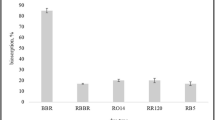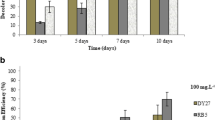Abstract
Three reactive dyes were rapidly adsorbed by the mycelium pellets of Penicillium oxalicum. Dye removal of Reactive Blue 19 was up to 60% in 10 min and 91% in 80 min. Dye adsorption isotherms fitted Langmuir model well and the maximum adsorption capacities at 20 °C were calculated to be 160 mg g−1 for Reactive Blue 19, 122 mg g−1 for Reactive Red 241 and 137 mg g−1 for Reactive Yellow 145, respectively. The pellets exhibited a high dye adsorption capacity (80–180 mg g−1) for all of the 3 dyes over a wide pH range (pH 2–10), and the maximum adsorption was obtained at pH 2. The adsorption capacity was mildly increased by increasing salinity.
Similar content being viewed by others
References
Angelis D, Rodrigues GS (1987) Azo dyes removal from industrial effluents using yeast biomass. Arquivos De Biologia E Technologia 30: 301–309.
Benito GG, Miranda MP, De Los Santos DR (1997) Decolorization of wastewater from an alcoholic fermentation process with Trametes Versicolor. Biores. Technol. 61: 33–37.
Borchert M, Libra JA (2001) Decolorization of reactive dyes by the white rot fungus Trameters versicolor in sequencing batch reactors. Biotechnol. Bioeng. 75: 313–321.
Chiou MS, Li HY (2003) Adsorption behavior of reactive dye in aqueous solution on chemical cross-linked chitosan beads. Chemosphere 50: 1095–1105.
Hu TL (1996) Removal of reactive dyes from aqueous solution by different bacterial genera. Water Sci. Tech. 10: 89–95.
Liu JQ, Liu HT (1992) Degradation of azo dyes by algae. Environ. Poll. 75: 273–278.
Mahony TO, Guibal E, Tobin JM (2002) Reactive dye biosorption by Rhizopus arrhizus biomass. Enzyme Microb. Technol. 31: 456–463.
Polman JK, Brechenridge CR (1996) Biomass-mediated binding and recovery of textile dyes from waste effluents. Textile Chem. Colorist 28: 31–35.
Robinson T, Chandran B, Nigam P (2002) Studies on desorption of individual textile dyes and a synthetic dye effluent from dyeadsorbed agricultural residues using solvents. Biores. Technol. 84: 299–301.
Sumathi S, Manju BS (2000) Uptake of reactive dyes by Aspergillus foetidus. Enzyme Microb. Technol. 27: 347–355.
Tobin JM, Cooper DG, Neufeld RJ (1984) Uptake of metal ions by Rhizopus arrhizus biomass. Appl. Environ. Microbiol. 47: 821–824.
Vaidya AA, Datye KV (1982) Environmental pollution during chemical processing of synthetic fibers. Colourate 14: 3–10.
Walker GM, Weatherley LR (2000) Biodegradation and biosorption of acid anthraquinone dye. Environ. Poll. 108: 219–223.
Weber JWJ (1972) Adsorption in Physicochemical Process for Water Quality Control. New York: JohnWiley & Sons, pp. 199–260.
Author information
Authors and Affiliations
Corresponding author
Rights and permissions
About this article
Cite this article
Zhang, S., Yang, M., Yang, Q. et al. Biosorption of reactive dyes by the mycelium pellets of a new isolate of Penicillium oxalicum . Biotechnology Letters 25, 1479–1482 (2003). https://doi.org/10.1023/A:1025036407588
Issue Date:
DOI: https://doi.org/10.1023/A:1025036407588




